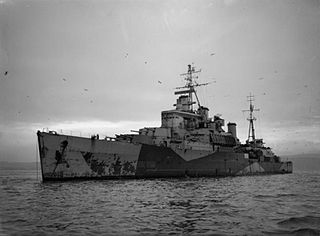
The 1949 Armistice Agreements were signed between Israel and Egypt, Lebanon, Jordan, and Syria. They formally ended the hostilities of the 1948 Arab–Israeli War and also demarcated the Green Line, which separated Arab-controlled territory from Israel until the latter's victory in the 1967 Arab–Israeli War.

HMS Newfoundland was a Fiji-class light cruiser of the Royal Navy. Named after the Dominion of Newfoundland, she participated in the Second World War and was later sold to the Peruvian Navy.

Duquesne was a Suffren-class frigate of the French Navy. She was designed to protect a fleet against air threats, surface ships, submarines, and, to a lesser extent, provide firepower against land objectives. She is the sister ship of Suffren. She is the eighth French vessel named after the 17th century admiral Abraham Duquesne. Duquesne was decommissioned in 2008.

The Anshan-class destroyers were the People's Liberation Army Navy's (PLAN) first destroyers. They were ex-Soviet Gnevny-class destroyers purchased in the 1950s. The Chinese later added HY-2 anti-ship missiles and removed some of the torpedo tubes, and redesignated as Type 6607. All four ships of the class had been stricken by 1992.

The Oregon City class was a class of heavy cruisers of the United States Navy. Although ten ships of this class were planned, only four were completed – one of those as a command ship. The three ships completed as cruisers were in commission from 1946 to 1980, one having been converted to a guided missile cruiser (CG).

HSwMS Sjölejonet was the lead ship of a class of nine naval submarines in the service of the Swedish Navy from just before World War II into the early Cold War. The submarines were ordered in response to the rising German threat to the south in the interwar period. Sjölejonet remained in service until 1959 and was sold for scrap in 1962.

The Moskva class, Soviet designation Project 1123 Kondor (condor) and S-703Project 1123M Kiev, was the first class of operational aircraft carriers built by the Soviet Union for the Soviet Navy.
HMS Altham was one of 93 ships of the Ham class of inshore minesweepers.

HMS Rocket was an R-class destroyer of the Royal Navy that saw service during Second World War. Built by Scotts Shipbuilding and Engineering Company in Greenock, Scotland, she was launched in October 1942 and commissioned in August 1943.

Project 122bis submarine chasers were a Soviet design which were exported throughout the communist bloc in the 1950s. The first ship, BO-270, was built at Zelenodolsk in 1945-1947 and a total of 227 were built for Soviet Navy (175) and border guard until 1955. As well as this, twenty Project 357 despatch vessels were built on the same hull, but were lightly armed.
HMS Superb was a Minotaur-class light cruiser of the Royal Navy. The ship entered service in 1945 and had a brief, quiet career before being decommissioned in 1957 after her modernisation was cancelled. She was broken up in 1960.

Hashemite Kingdom of Jordan/Israel Mixed Armistice Commission was the United Nations organisation of observers which dealt with complaints from Jordan and Israel to maintain the fragile cease fire along the demarcation line between Israel and Jordan. At the closing of the 1948 Arab-Israeli War, on 3 April 1949, the Hashemite Kingdom of Jordan signed a truce with Israel called the 1949 Armistice Agreements. The United Nations Truce Supervision Organization posted Military Observers as part of the Mixed Armistice Commissions (MACs) to Observe the truce on the Cease fire line and to liaise with the Israeli and Jordanian local area commanders. While the 1948 war was concluded with the 1949 Armistice Agreements it has not marked the end of the Arab–Israeli conflict. The HKJ/IMAC was the organisation which monitored the Jordan/Israel truce agreement, the HJK/IMAC Headquarters was located in Jerusalem close to the Green Line and, through close liaison with the UNTSO headquarters in Government House, Jerusalem, was charged with supervising the truce, investigating border incidents, and taking remedial action to prevent the recurrence of such incidents along the Jordan/Israel Green Line.

Vulcain (M611) is a Vulcain-class minesweeper of the French Navy. She is classed by the French Navy as a BBPD type vessel and is used as a base ship for clearance divers.

HMS Melbreak was a Hunt-class destroyer of the Royal Navy. She was a member of the third subgroup of the class, and saw service in the Second World War. All the ships of this class were named after British fox hunts. She was the first Royal Navy warship with this name, after the Melbreak hunt in Cumbria. In 1942 she was adopted by the civil community of Cockermouth in Cumberland, as part of Warship Week.

HNLMS Noord-Brabant (D810) was a Holland-class anti-submarine destroyer of the Royal Netherlands Navy. The ship was from 1955 to 1974 in Dutch service. On 9 January 1974, HNLMS Noord-Brabant was rammed amidships by an English merchant ship. The damage was estimated to be expensive so the Royal Netherlands Navy decided to not repair the damage but instead decommission the ship earlier than planned. The ship's radio call sign was "PAIP".
HMS Snipe was a modified Black Swan-class sloop of the Royal Navy. She was laid down by William Denny and Brothers, Dumbarton on 21 September 1944, launched on 20 December 1945 and commissioned on 9 September 1946, with the pennant number U20.
This page is based on this
Wikipedia article Text is available under the
CC BY-SA 4.0 license; additional terms may apply.
Images, videos and audio are available under their respective licenses.












